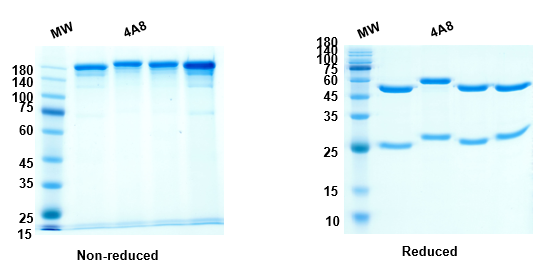Cart (0 Items)
Your cart is currently empty.
View Products



| size | 100µg |
|---|---|
| Isotype | IgG1 |
| Brand | ProteoGenix |
| Product type | COVID-19 products |
| Clonality | Monoclonal Antibody |
| Product name | Anti-Spike NTD antibody (4A8) |
|---|---|
| Species | Human |
| Expression system | Mammalian |
| Molecular weight | 150kDa |
| Purity | 85% |
| Buffer | PBS, pH7,5 |
| Form | Liquid |
| Delivery condition | Blue ice (+4°C) |
| Storage condition | 4°C for short term; -20°c or -80°C for long term |
| Brand | ProteoGenix |
| Host species | Mouse |
| Aliases /Synonyms | 4A8 antibody |
| Reference | PTXCOV-A548 |
| Note | For research use only. Not suitable for human use. |
| Isotype | IgG1 |
| Clonality | Monoclonal Antibody |
| Target | Spike NTD domain |
| Target species | SARS-CoV-2 |
SARS-CoV-2, the etiological agent of COVID-19 pneumonia, initiates the infection by binding the ACE2 (angiotensin-converting enzyme 2) receptor enriched on the surface of human epithelial cells. This initial interaction is mediated by the spike glycoprotein of the new coronavirus which, subsequently, undergoes proteolytic cleavage and rearrangement to form the membrane fusion complex. Due to its vital role in infection, the spike is currently the most biologically relevant target for the development of therapeutic antibodies and vaccines.
The anti-spike NTD antibody is a fully human IgG immunoglobulin recovered from the convalescent plasma of COVID-19 patients. The antibody was isolated by sorting peripheral blood mononuclear cells (PBMCs) to recover anti-SARS-CoV-2 antibody-secreting subpopulations. Antibody genes were further amplified from single cells (single-cell PCR) and the candidate antibodies were recombinantly expressed in Chinese hamster ovary (CHO) cell lines.
This specific anti-NTD antibody was shown to bind with high affinity to the S1 subunit of the spike glycoprotein of SARS-CoV-2. However, unlike previously described in prior studies with COVID-19 patients, this antibody targets the N-terminal domain (NTD) of the spike protein and not the receptor-binding domain (RBD), as expected.
Interestingly, despite recognizing an epitope outside the infection-initiating domain, the NTD antibody displayed a strong neutralizing activity in tests with authentic and pseudotyped SARS-CoV-2. Further crystallographic studies revealed that the antibody may allow the binding of the virus to its human receptor, ACE2, but prevent the conformational change of the spike, essential for membrane fusion.
The behavior has been observed before in studies with MERS-CoV, suggesting that a variety of different mechanisms are responsible for the efficient neutralization of these viruses in the human organism. Thus, the anti-spike NTD antibody has therapeutic value due to its SARS-CoV-2 neutralizing activity. However, it is also a valuable reagent for research to further elucidate the infection mechanism of the new coronavirus.

Anti-Spike NTD antibody (4A8), on SDS-PAGE under reducing and non-reducing conditions. The gel was stained overnight with Coomassie Blue. The purity of the protein is greater than 95%.
Send us a message from the form below
Reviews
There are no reviews yet.